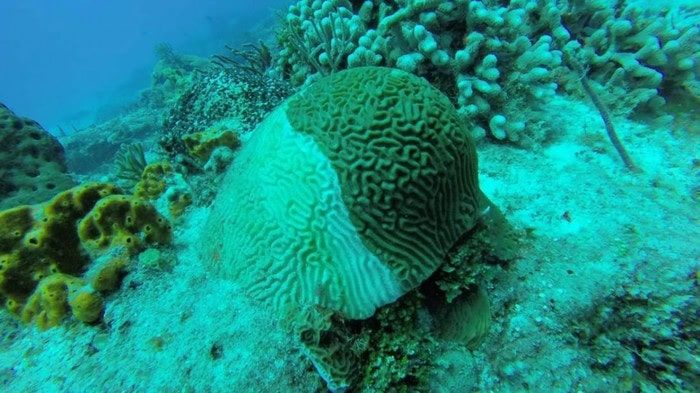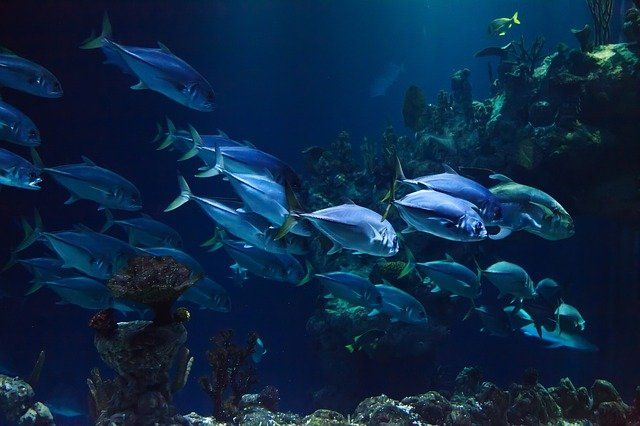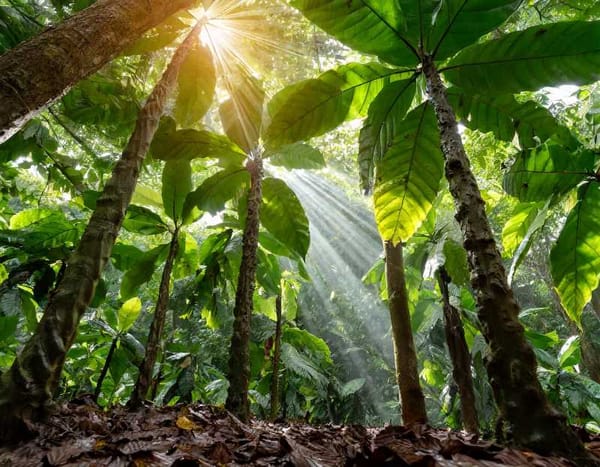White syndrome doesn't surrender on reefs, warns Akumal Ecological Center
The white syndrome disease (loss of coral tissue due to pathogens, which causes rapid death of the entire coral colony) has not yielded ground in Akumal's reefs.

The white syndrome disease (loss of coral tissue due to pathogens, which causes rapid death of the entire coral colony) has not yielded ground in Akumal's reefs, according to the results of the Coastal Ecosystems Program 2019, sponsored by Centro Ecológico de Akumal (CEA). The project is coordinated by Baruch Figueroa Zavala and aims to learn about the health of the corals; a thousand structures were analyzed through the implementation of the Bleach Watch program, in collaboration with HRI and the National Fisheries Institute.
In the first year since its detection in 2018, this disease caused coral mortality equivalent to what has happened in the last 10 years, so it represents a critical threat to the reef ecosystem, probably triggered in large part by the considerable amounts of decomposing organic material produced by the sargassum arrivals in 2017-2018. The Coastal Ecosystems Program (CEP) focuses on studying the condition of reef communities over time, seeking to describe changes in their structure and the responses of communities to stressors and their effects on them. With these elements, the historical and current condition of the reef can be determined from monitoring a range of sampling sites in the Akumal region and suggesting coastal management measures for its protection and sustainable use.
This program also includes a coral restoration project, which seeks to recover the functions of the reef and the environmental services it provides to local populations and at the regional level of the Mesoamerican Reef System (MAR). In 2019 they managed to "seed" nearly 6,000 fragments of eight coral species. CEA's PEC collaborates with several local and international organizations in the technical-scientific research of coral reefs, through projects that integrate the participation of researchers and university students in their field studies in Akumal's reefs.
Monitoring of reef communities
CEA has been implementing a Monitoring Project of the reef communities since 2006, seeking to describe their changes over time and to propose appropriate coastal management measures for their conservation and sustainable management, nurturing such an approach through continuous technical-scientific collaborations with national and international research centers and other civic associations. Giving continuity to this project, in 2019 CEA's PEC staff, in collaboration with UNAM (Sisal Campus, Yucatan), implemented several monitoring campaigns of reef bottom coverage and fish abundance and biomass in the Akumal Bays Aquatic Species Refuge Area (Aremba).
They also conducted coral bleaching and disease studies with technical support from Criap Inapesca and financed by the Healthy Reefs Initiative (HRI) and the MAR Fund. The research covered a wide network of sampling sites in the area, using indicators of their ecological condition such as hard and soft coral cover, macroalgae, cyanobacterial algae, carpet algae, coral encrusting algae, sponges, among others. Among the results obtained in 2019, it is worth mentioning that Akumal reefs showed a high dominance of the algal component in the reef and a low coverage of hard and soft corals probably due to the effects of the white syndrome disease recorded since mid-2018 and the coral bleaching phenomenon that occurred in the second half of 2019.
Cyanobacteria algae proliferated in 2019 probably in response to the high amount of dissolved organic matter in the water that drained from the underground aquifer into the reef, which has become increasingly contaminated by sewage discharges. The species most susceptible to this disease have been the brain-type corals and the pillar-forming coral (Dendrogyracylindrus), so the latter is, unfortunately, disappearing altogether from the reefs of the Mexican Caribbean.
In addition, it was observed that in 2019 coral bleaching in Akumal was the most severe recorded in recent years, probably due to the great stress that corals were already suffering from the syndrome and marine pollution, coupled with the increase in seawater temperature in the summer months, which represents its main trigger in a historical context. More than 40 percent of the 1,000 corals sampled showed bleaching, so further research is needed in 2020 to identify whether these corals have recovered or have become mortality statistics.

Robots will take care of coral reefs in Cancun and Riviera Maya
Alejandro Gómez Casso said that, along with a group of entrepreneurs, he is considering investing in robots to monitor the Mesoamerican Reef System off the coast of Cancún and the Riviera Maya to protect the recent 20,000-foot coral plantation. After attending the 'Consumer Electronic Show', a fair known as the most important in information technology, Gomez Casso said that recently was released SoFi, a robot that aims to protect and understand marine life.
"If the necessary amounts are achieved, the robot could patrol the reefs up to 18 meters deep and travel along the coast at speeds of up to half its length per second," he explained. SoFi, short for Soft Robotic Fich, makes it possible to monitor the environment, monitor pollution, and gather information on the behavior of marine life. However, it is not the only option for safeguarding coral reefs.
In the United Kingdom LarvalBot was created, which disperses coral larvae to repopulate reefs damaged by weather conditions. This has succeeded in replacing missing algae and improving conditions for fish reproduction. "The barrier reef in our country was affected by the massive arrival of sargassum last year. That is why, together with a group of businessmen, we are seeking to invest in this type of technology to recover this natural barrier, since corals also help to reduce the impact of hurricanes and other natural phenomena," he explained. Finally, Gómez Casso called on the business world to join this initiative whose sole purpose is to preserve the country's marine ecosystems.
White syndrome: rare disease threatens the Mexican Caribbean corals
The majestic range of reds, yellows, and violets on the reefs of the Mexican Caribbean is turning into a white mortecine, unleashing a desperate search by scientists to understand and combat the mysterious disease that kills the corals of the Mesoamerican Reef System. In a little more than a year, these reefs have lost more than 30% of their coral cover due to this disease dubbed the "white syndrome," which converts these colorful organisms into inert calcium carbonate skeletons.
Experts warn that the plague could kill much of the reef, a magnificent arch of more than 1,000 kilometers of coral shared by Mexico, Belize, Guatemala, and Honduras, the largest in the world after Australia's Great Barrier Reef. Its disappearance would also devastate the vital tourism industry around it, although tourism is likely to be at the root of the problem. The white syndrome was first detected in July 2018 in the Arrecifes National Park of Puerto Morelos, in the northern Mexican Caribbean, when scientists discovered that the corals were getting sick and dying quickly.
Sharing their findings with the international community, they confirmed their fears: it was the same "lethal" disease detected off the coast of Florida since 2014, explains Melina Soto, a representative in Mexico for Healthy Reefs for Healthy People. In 15 months, the plague has advanced more than 400 kilometers south of the Mesoamerican reef to Belize. Within weeks, this pathogen can destroy the living tissue of coral colonies that took decades to form, warns Soto. "If we continue at this rate, we can predict that this ecosystem will be collapsing in the next five or 10 years".
Probable extinction
According to scientists, the white syndrome is more dangerous than coral bleaching, another disease that has affected several of the planet's reefs, such as the Australian reef. The bleaching of corals - which are colonies of tiny animals - is caused by the loss of the microalgae known as zooxanthellae that live inside them and give them their brilliant color. Caused by any environmental stress, such as rising temperatures, coral bleaching can be overcome if the environment recovers.
The white syndrome is lethal
"It is a detachment of coral tissue that dies and when it detaches leaves exposed the skeleton, which is white," said Claudia Padilla, of the Regional Fisheries Research Center (Crip) in Puerto Morelos. To an inexperienced eye, the impact of the syndrome is still not as visible. "I had never seen corals and they seemed wonderful to me, I would never have thought they were dying," said Emanuel Fernández, a 34-year-old Argentine chemical engineer after a snorkeling trip to Isla Mujeres, in the Mexican Caribbean. Experts, on the other hand, do notice the damage.
"Before you used to go, dive and see the colonies on the reefs you frequented, now we go and all those colonies are dead." According to Padilla, 25 of the 40 species of corals on the Mesoamerican reef have been affected by this disease, and three are at imminent risk of extinction. They are even working on a project to genetically safeguard coral species endangered by this plague, to restore the reef in the future.
Impact of tourism
Researchers march against the clock to understand the causes of the white syndrome. One likely cause is poor water quality caused by a variety of factors, such as the dumping of sewage, the decomposition of twill, an algae whose presence has increased greatly in recent years, another environmental emergency for the region, or even the disproportionate use of sunscreens, sunscreens, and repellents with which people enter the water, banned a couple of months after it was confirmed that it affects the reproduction of corals. "A particle of the blockers, oxybenzone, affects and impedes coral reproduction," warns Christopher González, regional director of the National Commission of Protected Natural Areas.
This month, authorities temporarily closed the "Palancar", "Colombia" and "El Cielo" reefs, which annually receive thousands of visitors arriving on cruise ships to the island of Cozumel. Authorities, the tourism industry, and the population must now seek a delicate balance: a level of tourism that does not kill the reef or the economy. So far in 2019, the reefs of the Mexican Caribbean have been visited by some 725,000 tourists, a figure similar to previous years. "If we lose the reef, we lose our main economic activity, which is tourism," warned María del Carmen García, director of the Arrecifes de Puerto Morelos National Park.




